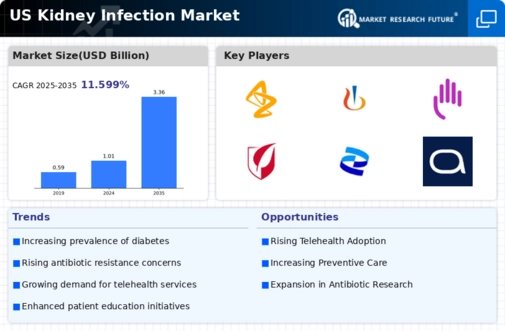Aging Population
The demographic shift towards an aging population in the United States serves as a significant driver for the kidney infection market. As individuals age, they often experience a decline in kidney function, making them more susceptible to infections. By 2030, it is estimated that nearly 20% of the U.S. population will be over 65 years old, which could lead to a corresponding increase in kidney-related health issues. This demographic trend suggests a growing need for healthcare services focused on kidney infections, including preventive care and treatment options. The aging population's unique health challenges may necessitate tailored approaches within the kidney infection market, thereby influencing the development of specialized therapies and interventions.
Rising Healthcare Expenditure
The rising healthcare expenditure in the United States significantly impacts the kidney infection market. As healthcare spending continues to rise, patients are more likely to seek medical attention for kidney-related issues, including infections. In 2025, healthcare spending is projected to reach approximately $4.5 trillion, indicating a robust investment in health services. This financial commitment facilitates access to advanced diagnostic tools and treatment options, thereby enhancing patient outcomes. Additionally, increased spending on healthcare resources may lead to improved public health initiatives, which could further drive demand within the kidney infection market. Consequently, the correlation between healthcare expenditure and market growth appears to be strong.
Increased Incidence of Comorbidities
The rising incidence of comorbidities, such as diabetes and hypertension, is a critical driver of the kidney infection market. These conditions are known to compromise kidney function, thereby increasing the risk of infections. In the United States, approximately 34.2 million adults are living with diabetes, a figure that is expected to rise. This growing population of individuals with comorbidities necessitates enhanced healthcare services focused on kidney health. As healthcare providers address the complexities of managing multiple health issues, the demand for specialized care in the kidney infection market is likely to increase. This trend underscores the importance of integrated healthcare approaches to effectively manage kidney infections in patients with underlying health conditions.
Increasing Awareness of Kidney Health
The growing awareness surrounding kidney health is a pivotal driver in the kidney infection market. Educational campaigns and health initiatives have been instrumental in informing the public about the risks associated with kidney infections. This heightened awareness is likely to lead to increased screening and early diagnosis, which could potentially reduce the severity of infections. As individuals become more proactive about their health, the demand for diagnostic services and treatment options in the kidney infection market is expected to rise. Furthermore, the emphasis on kidney health is reflected in the increasing number of healthcare programs aimed at educating patients about preventive measures, thereby fostering a more informed patient population.
Technological Innovations in Treatment
Technological advancements in treatment modalities are reshaping the kidney infection market. Innovations such as minimally invasive surgical techniques and novel pharmacological agents are enhancing treatment efficacy and patient comfort. For instance, the introduction of targeted antibiotic therapies has shown promise in effectively managing kidney infections while minimizing side effects. Moreover, the integration of telemedicine in patient care allows for more efficient monitoring and management of kidney health. These technological innovations not only improve patient outcomes but also drive market growth by attracting investment in research and development. As the healthcare landscape evolves, the kidney infection market is likely to benefit from ongoing advancements in treatment technologies.

















Leave a Comment